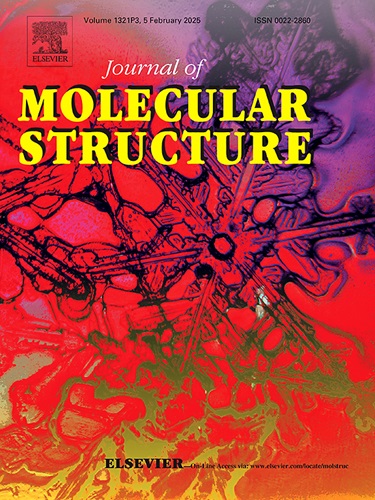Novel ionic liquid–Schiff base grafted on NH2-MIL-53(Al) hybrid sensor for selective and sensitive Zn2+ fluorescent sensing in complex matrices
IF 4
2区 化学
Q2 CHEMISTRY, PHYSICAL
引用次数: 0
Abstract
A novel hybrid sensor was constructed by grafting 1-(salicyl)-2,4-lutidinium hexafluorophosphate (Sal(lut+PF6−) onto NH2−MIL-53(Al) via a Schiff base reaction (Sal@MIL) for the highly selective and sensitive detection of Zn2+ ions. The chemical structure of Sal (Lut⁺PF₆⁻) was confirmed using 1H, 13C, 31P, 19F NMR and FT-IR spectroscopy, while NH2−MIL-53(Al) and the Sal@MIL sensor were characterized using XRD, BET surface area analysis, FT-IR, SEM, and XPS techniques. The Sal@MIL sensor exhibited a broad Zn2+ recognition capability. Under optimal conditions, it achieved a remarkable low limit of detection (0.11 ppb) and limit of quantification (0.36 ppb), along with excellent selectivity against potentially interfering metal ions. The sensing mechanism relies on the inhibition and destruction of C![]() N isomerization and excited-state intramolecular proton transfer (ESIPT) upon Zn2+ binding, resulting in a significant fluorescence response. Practical applications were successfully demonstrated through accurate Zn2+ quantification in diverse real-world matrices including tap water, seawater, human blood serum, and various medications with results rigorously validated by ICP-MS analysis. The Sal@MIL sensor offers a high sensitivity, selectivity, and rapid response for Zn2+ ion detection in complex matrices.
N isomerization and excited-state intramolecular proton transfer (ESIPT) upon Zn2+ binding, resulting in a significant fluorescence response. Practical applications were successfully demonstrated through accurate Zn2+ quantification in diverse real-world matrices including tap water, seawater, human blood serum, and various medications with results rigorously validated by ICP-MS analysis. The Sal@MIL sensor offers a high sensitivity, selectivity, and rapid response for Zn2+ ion detection in complex matrices.
新型离子液体-希夫碱接枝于NH2-MIL-53(Al)杂化传感器上,用于复杂基质中选择性和灵敏的Zn2+荧光传感
通过席夫碱反应(Sal@MIL)将1-(水杨基)-2,4-六氟磷酸镥(Sal(lut+PF6−)接枝到NH2 - MIL-53(Al)上,构建了一种新型杂交传感器,用于高选择性和高灵敏度检测Zn2+离子。用1H、13C、31P、19F NMR和FT-IR光谱证实了Sal (Lut + PF₆⁻)的化学结构,用XRD、BET表面积分析、FT-IR、SEM和XPS技术对NH2 - MIL-53(Al)和Sal@MIL传感器进行了表征。Sal@MIL传感器具有广泛的Zn2+识别能力。在最佳条件下,它达到了显著的低检测限(0.11 ppb)和定量限(0.36 ppb),以及对潜在干扰金属离子的极好选择性。传感机制依赖于Zn2+结合时CN异构化和激发态分子内质子转移(ESIPT)的抑制和破坏,从而产生显著的荧光响应。通过在自来水、海水、人血清和各种药物等多种现实世界基质中精确定量Zn2+,成功证明了实际应用,并通过ICP-MS分析严格验证了结果。Sal@MIL传感器为复杂矩阵中的Zn2+离子检测提供了高灵敏度,选择性和快速响应。
本文章由计算机程序翻译,如有差异,请以英文原文为准。
求助全文
约1分钟内获得全文
求助全文
来源期刊

Journal of Molecular Structure
化学-物理化学
CiteScore
7.10
自引率
15.80%
发文量
2384
审稿时长
45 days
期刊介绍:
The Journal of Molecular Structure is dedicated to the publication of full-length articles and review papers, providing important new structural information on all types of chemical species including:
• Stable and unstable molecules in all types of environments (vapour, molecular beam, liquid, solution, liquid crystal, solid state, matrix-isolated, surface-absorbed etc.)
• Chemical intermediates
• Molecules in excited states
• Biological molecules
• Polymers.
The methods used may include any combination of spectroscopic and non-spectroscopic techniques, for example:
• Infrared spectroscopy (mid, far, near)
• Raman spectroscopy and non-linear Raman methods (CARS, etc.)
• Electronic absorption spectroscopy
• Optical rotatory dispersion and circular dichroism
• Fluorescence and phosphorescence techniques
• Electron spectroscopies (PES, XPS), EXAFS, etc.
• Microwave spectroscopy
• Electron diffraction
• NMR and ESR spectroscopies
• Mössbauer spectroscopy
• X-ray crystallography
• Charge Density Analyses
• Computational Studies (supplementing experimental methods)
We encourage publications combining theoretical and experimental approaches. The structural insights gained by the studies should be correlated with the properties, activity and/ or reactivity of the molecule under investigation and the relevance of this molecule and its implications should be discussed.
 求助内容:
求助内容: 应助结果提醒方式:
应助结果提醒方式:


